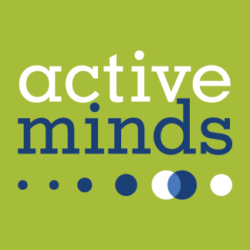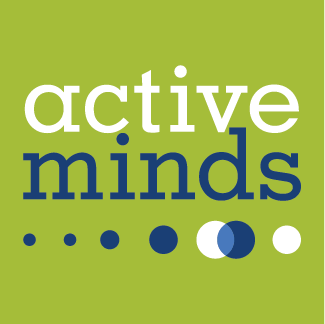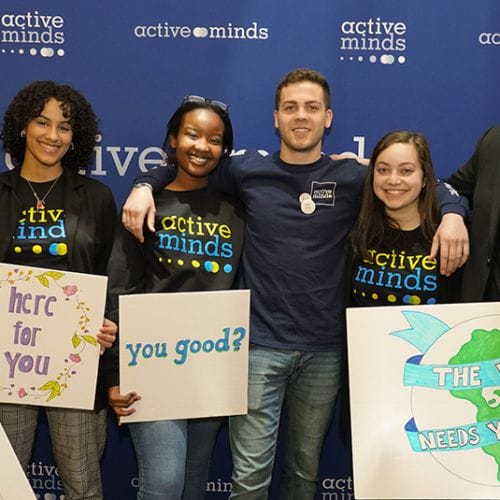Students, especially college students, were hit hard by the fallout of the COVID-19 pandemic. We know from Active Minds’ recent survey of over 3,000 students that 91% of young adults say that COVID-19 has caused stress and anxiety and over 80% say they’ve experienced isolation, loneliness, sadness, and disappointment. Students have been working diligently to maintain their communities, support their peers, and advocate for policies and structures they need at this moment.
Active Minds’ weekly Student Chats have highlighted the creativity, positive attitude, and engaged advocates of student mental health leaders. We are so impressed with their resilience and motivation and want to share some of what we’ve learned in the last few weeks:
Member and Peer Engagement
Student mental health leaders are making additional efforts to connect with their members and engage them in meaningful ways. One of the top recommended tips from students was to continue to have regularly recurring meetings so members could develop a sense of routine and have something to look forward to.
-
How can we stay connected to each other and feel like we know what’s happening week-to-week?
- Send weekly or bi-weekly emails to communicate upcoming events or meetings, updates from your school, and ways to be in touch with each other.
- Update social media accounts and develop a strategy for how often you want to post which kinds of messages on what platforms.
- Work with your chapter advisor to develop a direct pipeline of information that can be shared through your chapter.
-
How can we support individual student leaders?
- Plan dedicated “office hours” or coffee chats either one-on-one or in small groups.
- Provide space in meetings for people to talk about their days or weeks. Try to find the right balance of giving people space to be open and honest and making sure students who need additional support are connecting with resources.
- Give members buy-in on what happens next, whether that means hosting a few meetings over the summer, planning a kick-off event in the fall term, or having a hand in social media content strategy.
- Celebrate your graduating members and leaders by hosting a virtual graduation or thank you ceremony.
Leadership Transition
Continued student mental health leadership at schools is more important than ever. For many student organizations, leadership transition happens in the late spring term as some people head towards graduation and help transition new people into their roles. Many students have adapted their traditional, in-person, leadership transition to a virtual format to make sure their new leaders are trained and prepared to go into this summer and fall.
-
Identifying and finding potential leaders
- Invite chapter members and your student body to contribute to a blog or social media page and ask some potential chapter leaders to help you maintain an active social media presence.
- Ask leaders and members to contribute to and lead discussions or activities during your meetings.
- Reach out directly to students who have shown interest in your work but may not have been able to attend regularly scheduled meetings or programs on campus to see if there are ways they can take on leadership during remote learning.
-
Holding elections or designating roles
- Work with your current leadership team and advisor to look at your chapter’s constitution and any requirements from your school around elections or leadership transition.
- Ask candidates to record a short video of them giving a speech or you can ask that they submit a paragraph that you put into a voting or survey site (ex: Survey Monkey) to send to your membership for voting.
- Be as transparent about the process for elections and to ensure anonymity for votes, ask if your advisor might be willing to tally the votes or have the login information for your survey collection account.
-
Planning for and training your new leaders
- Put all the documentation for your chapter in a Dropbox folder or Google Drive folder to share and pass on to your new leaders. Make sure your advisor has administrator access to these folders.
- Plan a meeting for your current leadership team, advisor, and the incoming leaders to meet and discuss each person’s role and to discuss any planning that’s already taken place for the summer and fall term.
- Continue to support your incoming student leaders after your graduation for an amount of time to make sure they have a resource if they run into problems or have questions.
- Be sure that your chapter leader’s contact information is up to date with your student activities office and the Active Minds National Office.
Active Minds is #HereForYou
Active Minds is working hard to make sure you have the data, resources, communication avenues, and support through this pandemic.
- Visit our COVID-19 Hub for resources, stories, live content, and more.
- Connect with your fellow student mental health leaders on the Active Minds Student Network Slack team. Our Slack network is normally reserved for Active Minds chapter leaders but, thanks to our friends at just., we’ve been able to open our network to any student who wants to join!
- Be in touch with Chapter Manager, Robyn Suchy, during his weekly office hours, on slack (message robyn_nationalstaff), and via email (robyn@activeminds.org).
And don’t forget to register to participate in our weekly Student Chats on a variety of topics and have conversations like these with your fellow student leaders and the Active Minds National team!









